As we come closer to the Copa América in the United States of America this year, it is clear that Venezuela are not amongst the favourites.
Indeed, the usual suspects of the likes of Brazil and Argentina are clearly ahead of the Venezuelans and even Uruguay, Colombia and the hosts are seen as having a better chance of reaching the latter stages of the tournament.
They are in group B of the tournament against Ecuador, Mexico and Jamaica — and, realistically, they will be battling for second place.
That said, however, it would be remiss to completely rule out the Venezuelans, given that in recent years, they have had some very interesting young players come through and break into the national team setup.
Their coach, Fernando Batista, must find a way to combine these young players with some of their more experienced compatriots.
What lets the Venezuelans down, though, is their lack of depth in each position of the pitch.
They will be very much reliant on their starting players if they are to make an impact on the tournament, and any injury to a key player will undoubtedly derail them.
In this tactical analysis and scout report, we will assess Venezuela’s chances in the upcoming Copa América, assess the tactics likely to be adopted by Batista and provide an analysis of the selected squad.
Predicted Starting XI
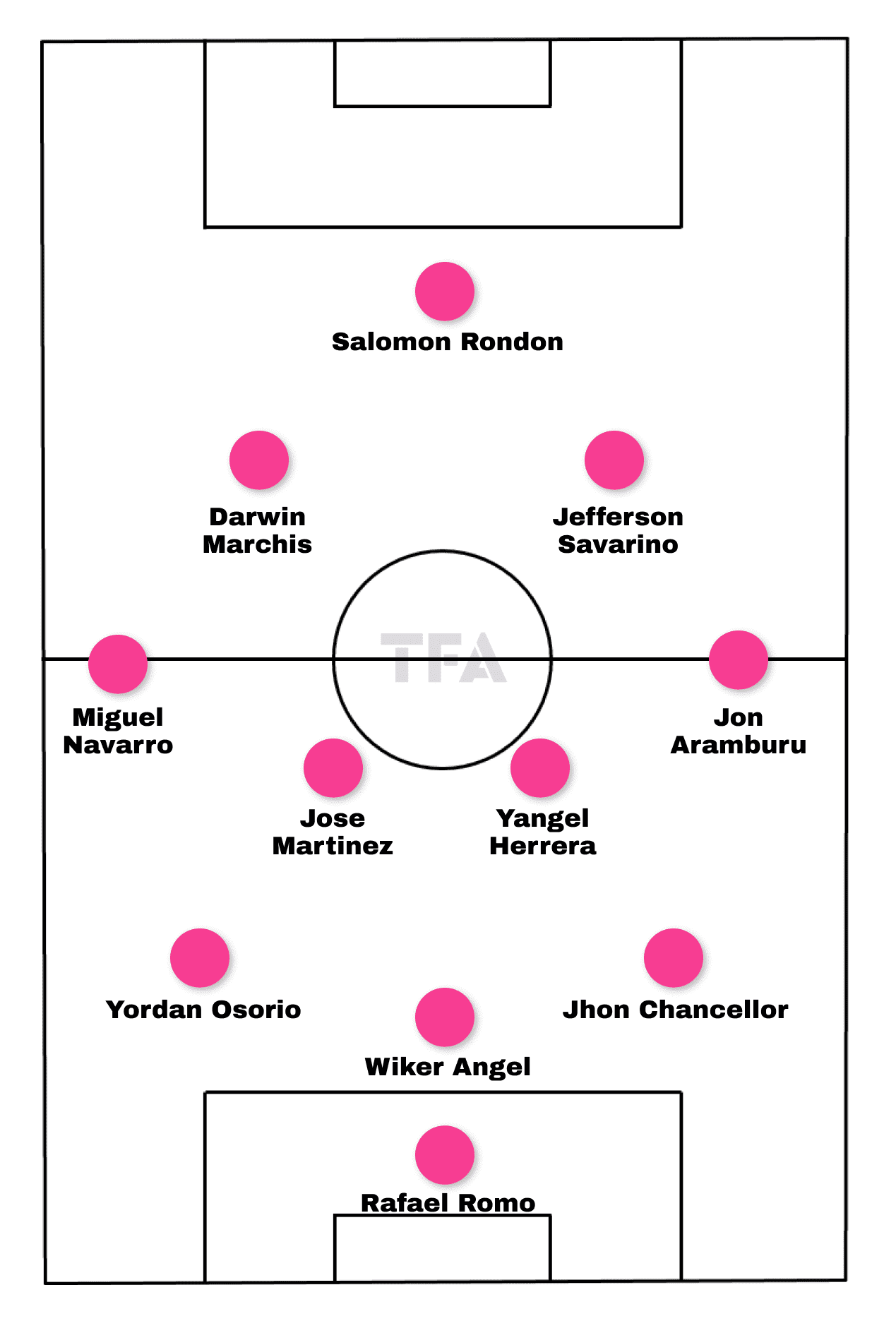
We believe that Venezuela will line up in a back-three system, although the wide midfielders could well be interpreted as full-backs or wing-backs, depending on the situation.
In the final third, Rondón will lead the line for Venezuela, while the attacking midfielders behind him will be versatile in terms of coming narrow or moving out wide to create opportunities to isolate.
The midfield two will be dependent on fitness at this point, and although we have picked a two in the centre of Yangel Herrera and José Martínez, there is every chance that Tomás Rincón could partner Herrera.
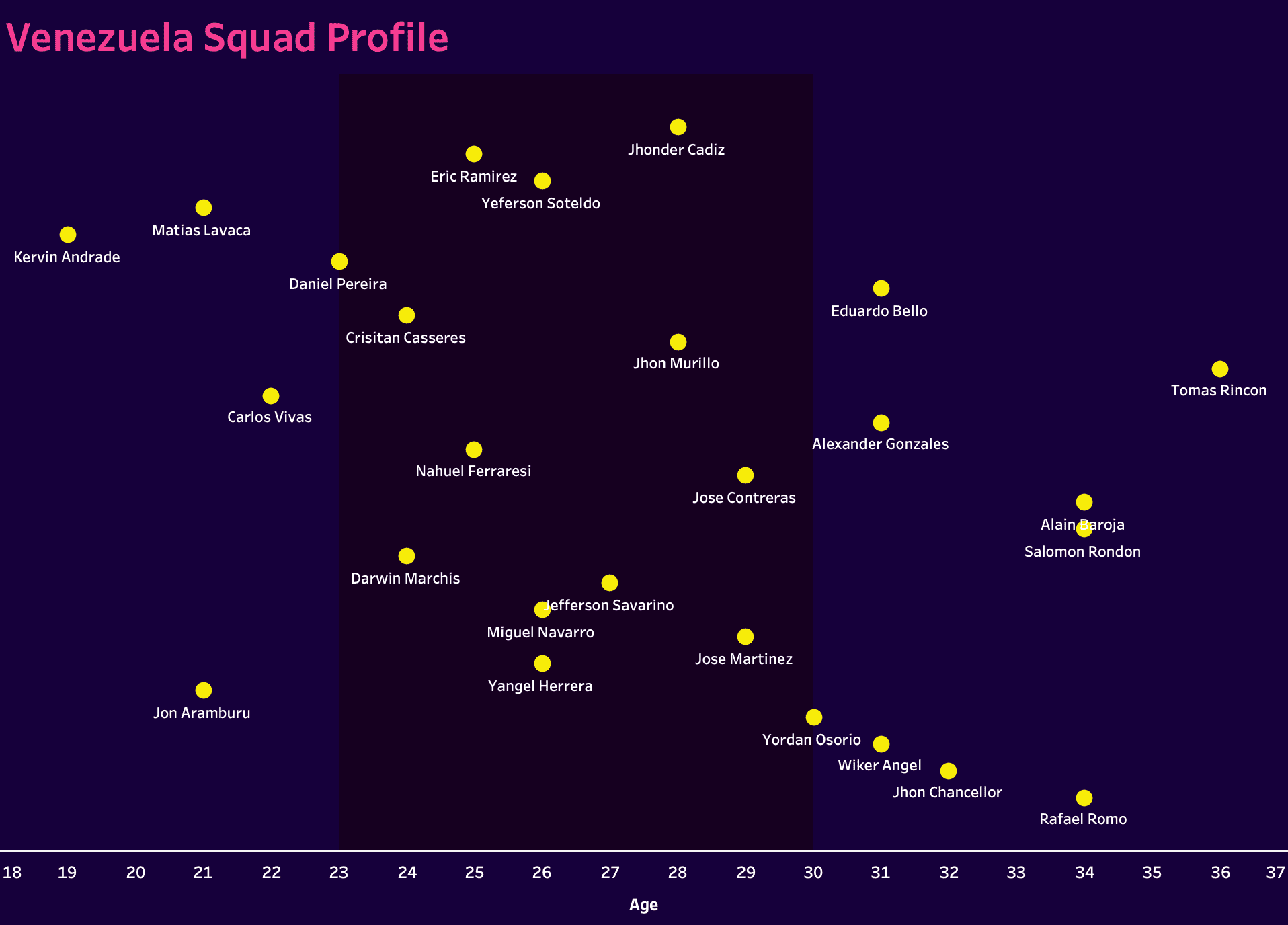
As you can see from the age profile of the Venezuelan squad, they are well balanced, with the majority of the squad in the peak age range.
Jon Aramburu will play as the right wing-back or midfielder, but other than that, the majority of the team will be peak or just above peak in terms of their ages.
Attacking Phase
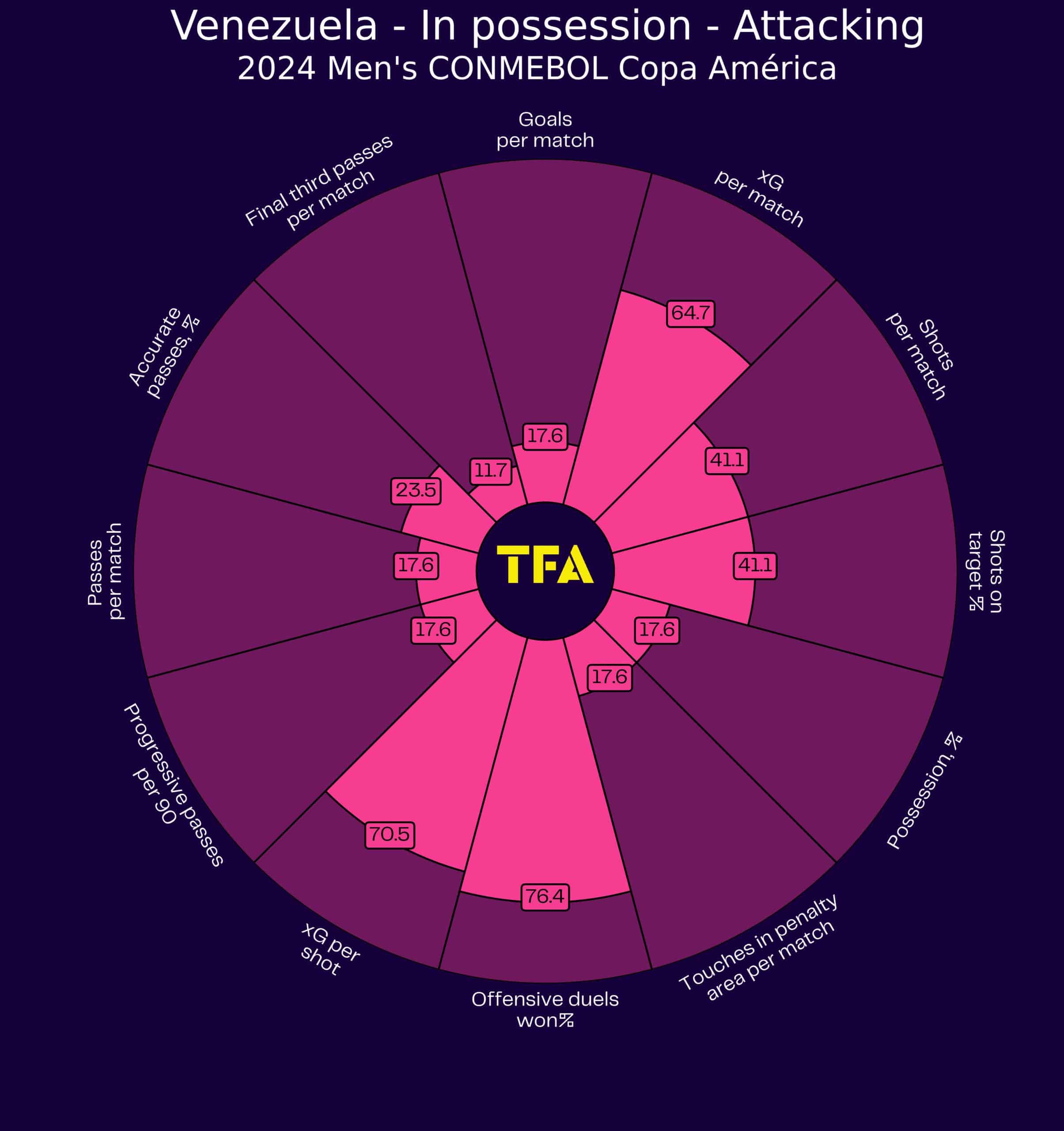
When we look at the data for Venezuela over the last calendar year in the attacking phase, we see a side that is not possession-dominant in general.
They do not play a high volume of passes, and they are not a team that will look to build through the thirds.
What they do well, though, is work to create chances that yield a higher value of xG.
This is the perfect approach for a team that has a focal point striker at the top of its attack.
In the attacking phase of the game, Venezuela are fluid and versatile in their approach, but the presence of Salomón Rondón as the 9 and the focal point of the attack is still the key to unlocking their potential.
The Pachuca forward was never a player who relied heavily on pace, so his athletic regression did not hold him back.
He does, however, thrive when it comes to playing back to goal and being effective in the build-up phase.
We expect to see Venezuela start the tournament in a back-three system, and there will be two narrow attacking players in the final third who will work to continually get around the ball to support Rondón when the ball is played forward.

Recently, Venezuela played against Italy in a friendly to prepare for this upcoming tournament.
Even against a team with more quality throughout their squad, the Venezuelans had interesting moments.
In this image, we see how effective Rondón can be as a focal point and a platform for the attack.
As the ball is played forward to Rondón’s feet, we see the striker coming back towards the ball and pulling defenders out with him.
As he receives the ball, this triggers his teammates to start moving forward and into attacking areas.
From these positions, it is fair to say that he is not a threat to take the ball on the half-turn.
Instead, he will look to link the play and find a player making runs to support.
Here, he uses the option to pass out to the left side, where Machís is making a high-intensity run to bypass the defender.
He could also, however, link back into midfield or out to the near side, where he has supporting options.
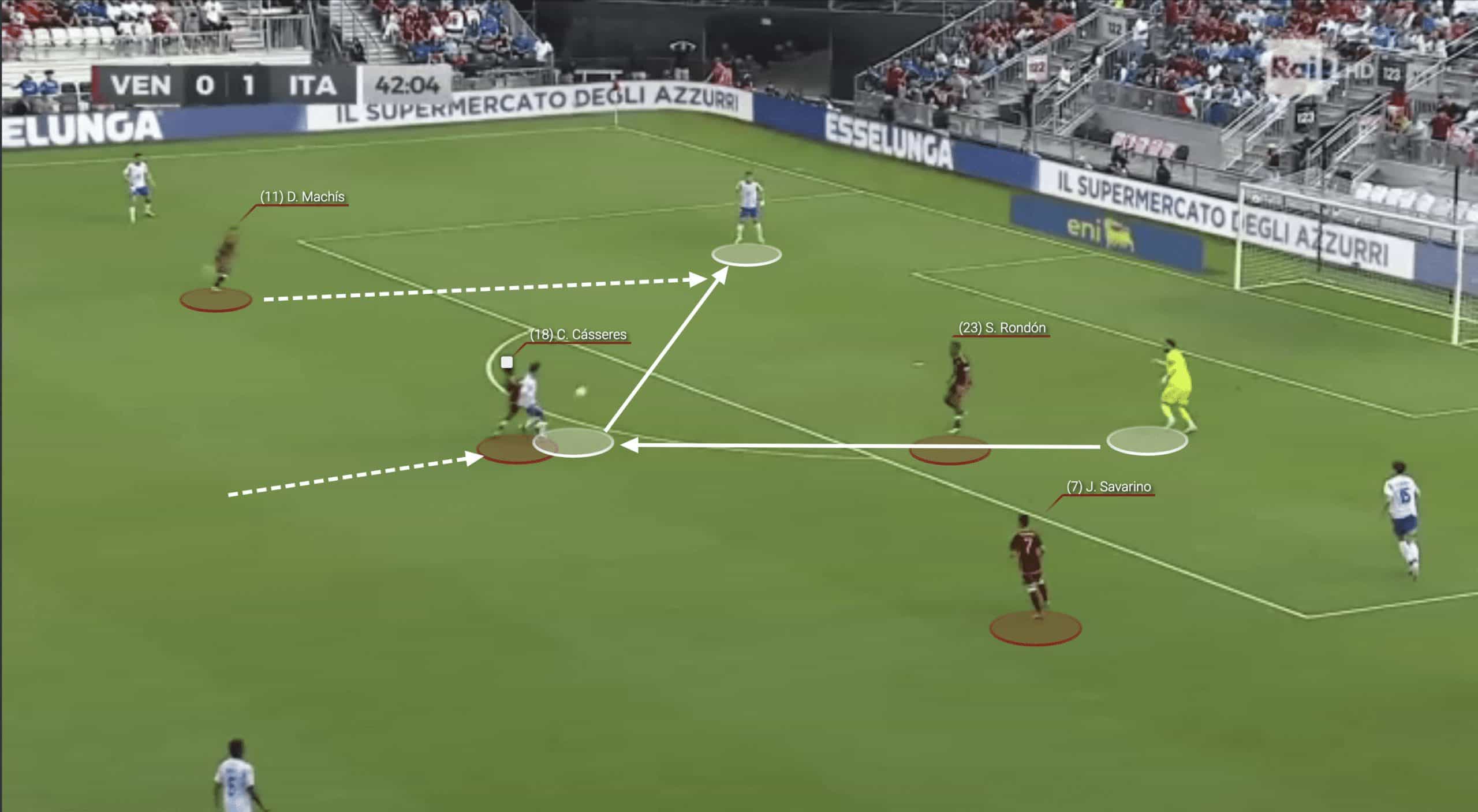
Interestingly, while Venezuela are not a team that will typically defend in a high block or play a high-tempo pressing style of football, they are capable of reacting quickly to moments of transition and acting on triggers to look to regain possession.
This is further enhanced by the fact that Venezuela are not possession-based or dominant.
As a result, they have to act more as a team that attacks through moments of transitions to outplay the opposition defender and create chances.
In this example, we see the Italians trying to play out from their goalkeeper.
As the ball is first played to the midfielder, who is facing his own goal, this is an immediate trigger, and the Venezuelan midfielder jumps high to put pressure on the ball from behind.
These situations can then lead to immediate turnovers in possession, and here, the ball to the centre-back is loose, and Machís wins the duel to score.

When they attack quickly in moments of transition in this manner, the Venezuelans will look to get attacking players isolated in wide positions where they can attack 1v1.
The likes of Yeferson Soteldo and Darwin Machís, in particular, are dangerous when they can get isolated against the opposition full-back, and both have the ability to attack on the inside or the outside.
By creating 1v1 situations in this manner, Venezuela are looking to find ways to penetrate into the penalty area, and as soon as they get an opposition defender isolated in this way, they will look to flood attacking players towards the penalty area to attack the cross.
We see this in this example with Soteldo isolated 1v1 on the near side.
He is one of the most dynamic dribblers and ball carriers in South American football, and in these positions, he will break into the penalty area in possession.
This, once again, creates a threat for a target forward type like Salomón Rondón, given their movement in the area and ability to attack the ball in the air.
Defensive phase
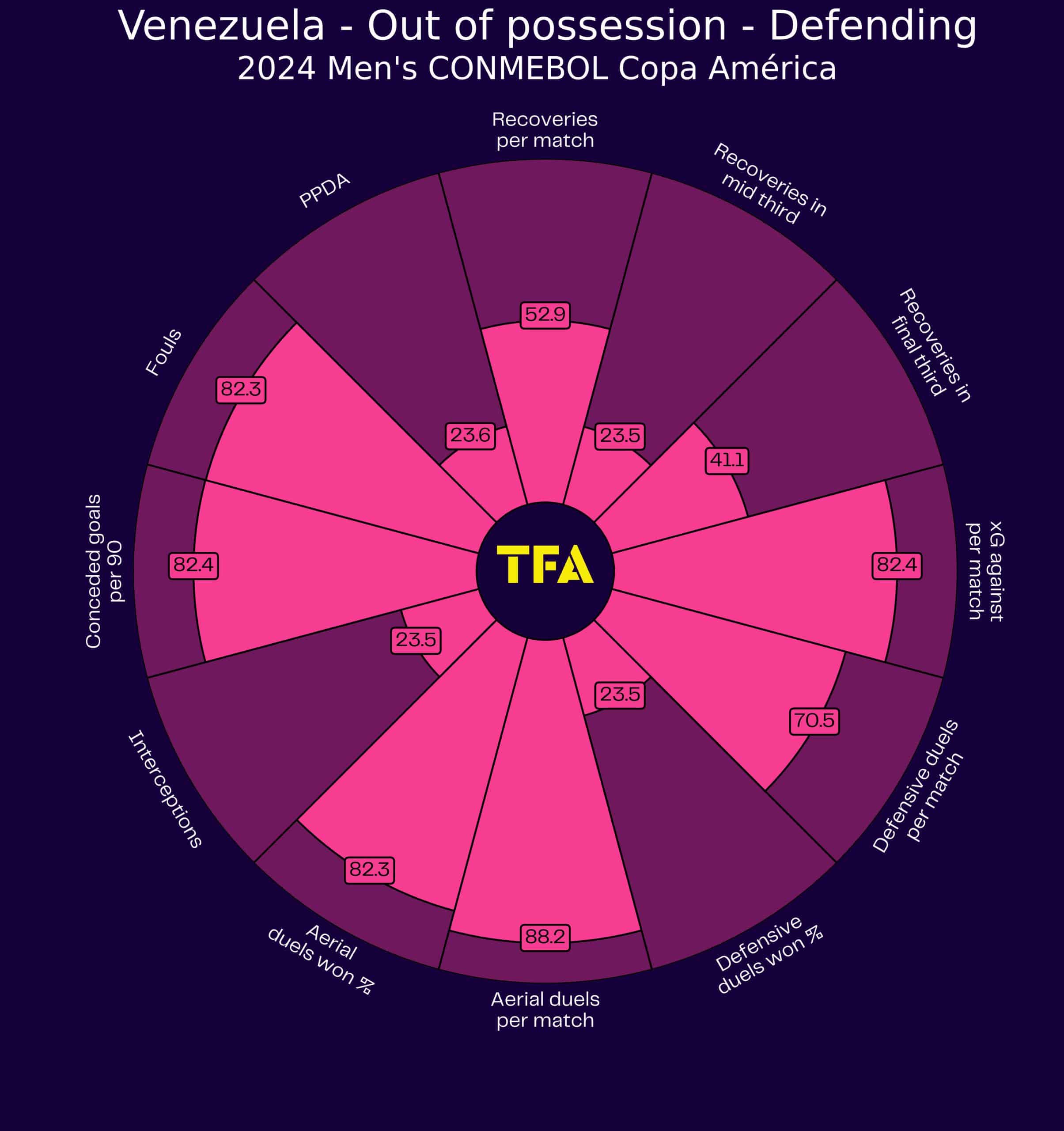
The above pizza chart gives us an indication of the defensive style that we haven seen from Venezuela over the course of the last calendar year of international matches.
If we see Venezuela line up from the start of the tournament in a 3-4-3 shape, they are likely to adopt a flexible approach out of possession.
Unless there are any prominent triggers from the opposition as they are looking to build their attack, they will drop into a medium block to defend, with the two more advanced wide players looking to work with the striker to close off the centre of the pitch.
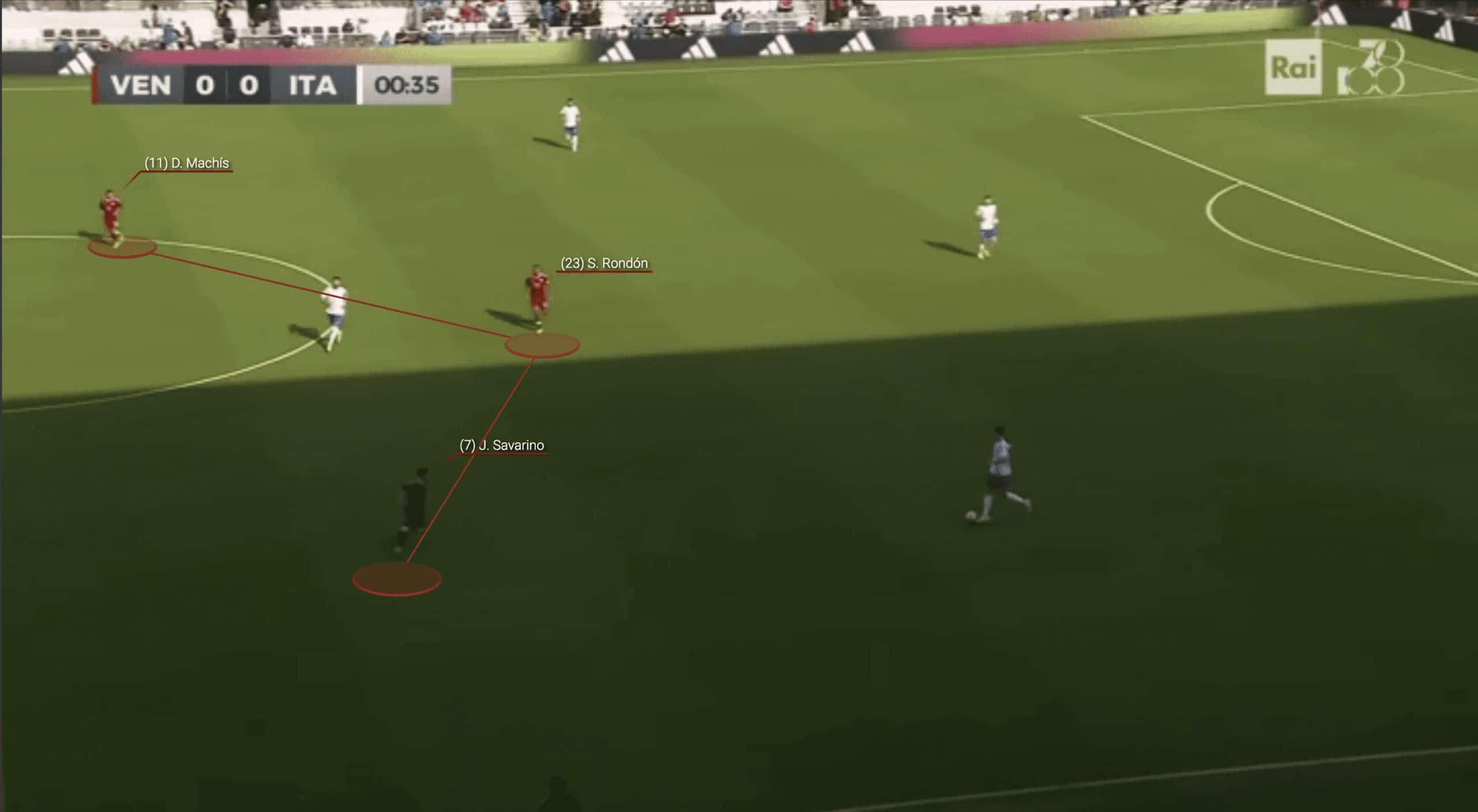
In blocking off the central areas in this kind of situation, Venezuela are effectively looking to force the opposition attack to go around the outsides of their defensive blocks.
As the ball then goes wide, the idea is that the defensive block will shift across in that direction, and the opposition attack can then get pinned on that side of the pitch.
This image shows an example of Venezuela’s initial pressing structure.
As Italy attack, we see Machís, Rondón, and Savarino in a narrow v shape across the centre of the pitch.
If the Italians continue to attack in this manner, if they pass down the line, Savarino should crash down on that side of the pitch to support the midfield line behind the initial press.
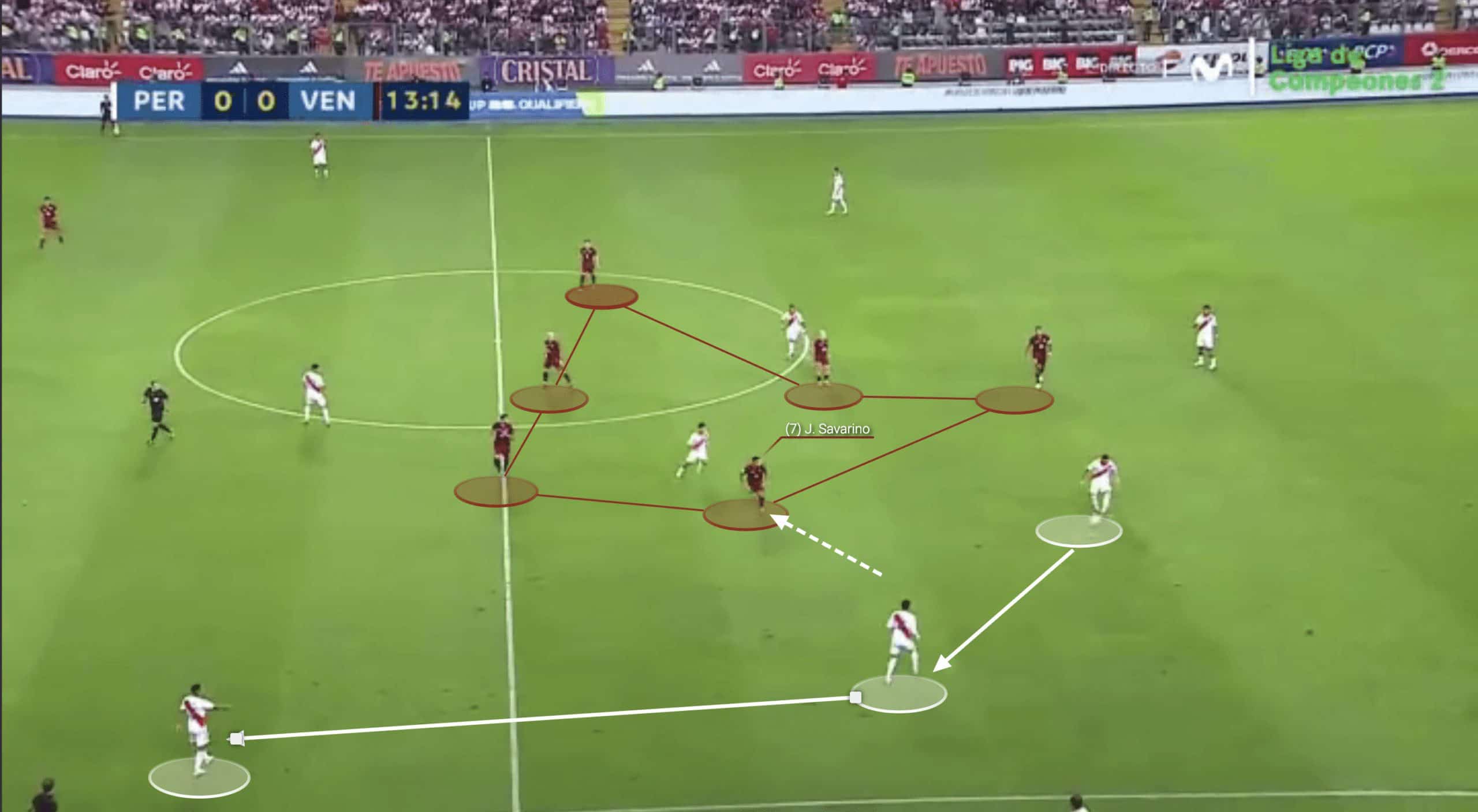
The problem that Venezuela tend to have from a defensive perspective and the biggest issue that they will face in this tournament comes when they are caught out of position as the opposition play away from the centre.
If one player gets too aggressive or gets dragged out of position in this system, then suddenly, the opposition can have open passing lanes on the outside that they can exploit.
In this example, we see Peru looking to build out from the first line in their match against Venezuela.
You can see that the Venezuelans are positioned centrally here to block off the centre of the pitch.
However, as the Peruvians pass the ball on the outside, we see that Savarino had been attracted inside and into the initial defensive block.
With the wide player on the near side essentially out of position and too narrow we then see how easy it is for Peru to play out and attack down the nearside.
By moving quickly through the passes that we have highlighted on this image, we show how Peru were able to easily outplay and bypass six players in the Venezuelan defensive block.
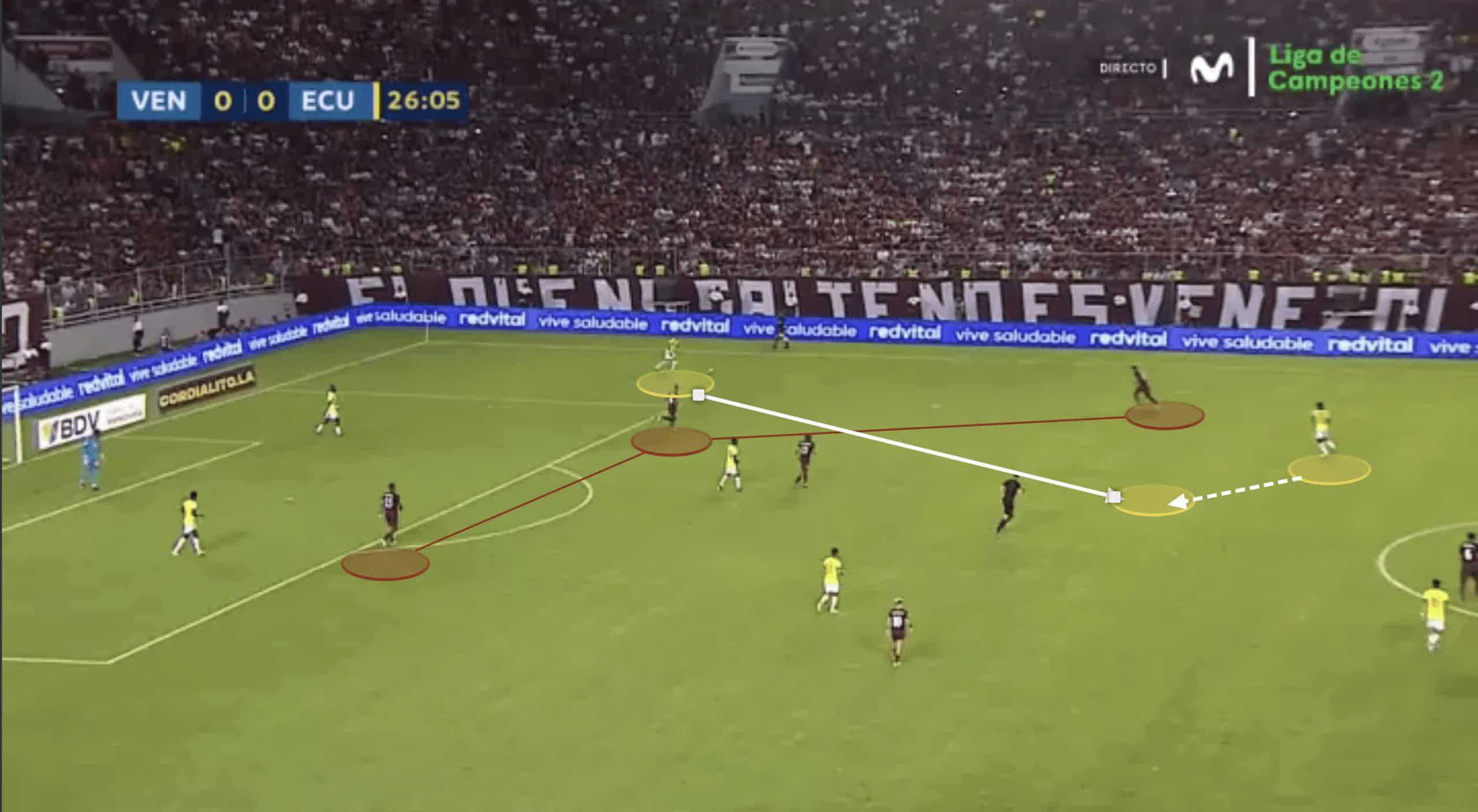
Venezuela can also struggle from a defensive point of view when they start to get dragged out of their defensive shape and allow the opposition to stretch their spacing and connections between teammates.
When the medium block is not in place, and if Venezuela are not well structured behind the initial pressing action, then they can get easily picked off and played through or around.
In this example, we see the opposition playing out from the back, and Venezuela have not dropped off into a medium block yet.
As a result, they are easily picked off by a single pass to find a midfielder rotating into space in the opposition half.
This single pass immediately takes five Venezuelan players out of the game.
If they want to be successful in this tournament, then Venezuela have to maintain their defensive spacing and structure in a 3-4-3 but to do so, they cannot be caught in two minds on how to play defensively.
Transitions
When they defend and play in a medium to deep defensive block, it is important for Venezuela to ensure that they are in position to launch attacks quickly in moments of transition.
As we have said above, the idea, when things go well, defensively is for Venezuela to force the opposition to attack in the wide areas and then attack the ball as it goes wide to force possession regains and start their transition.
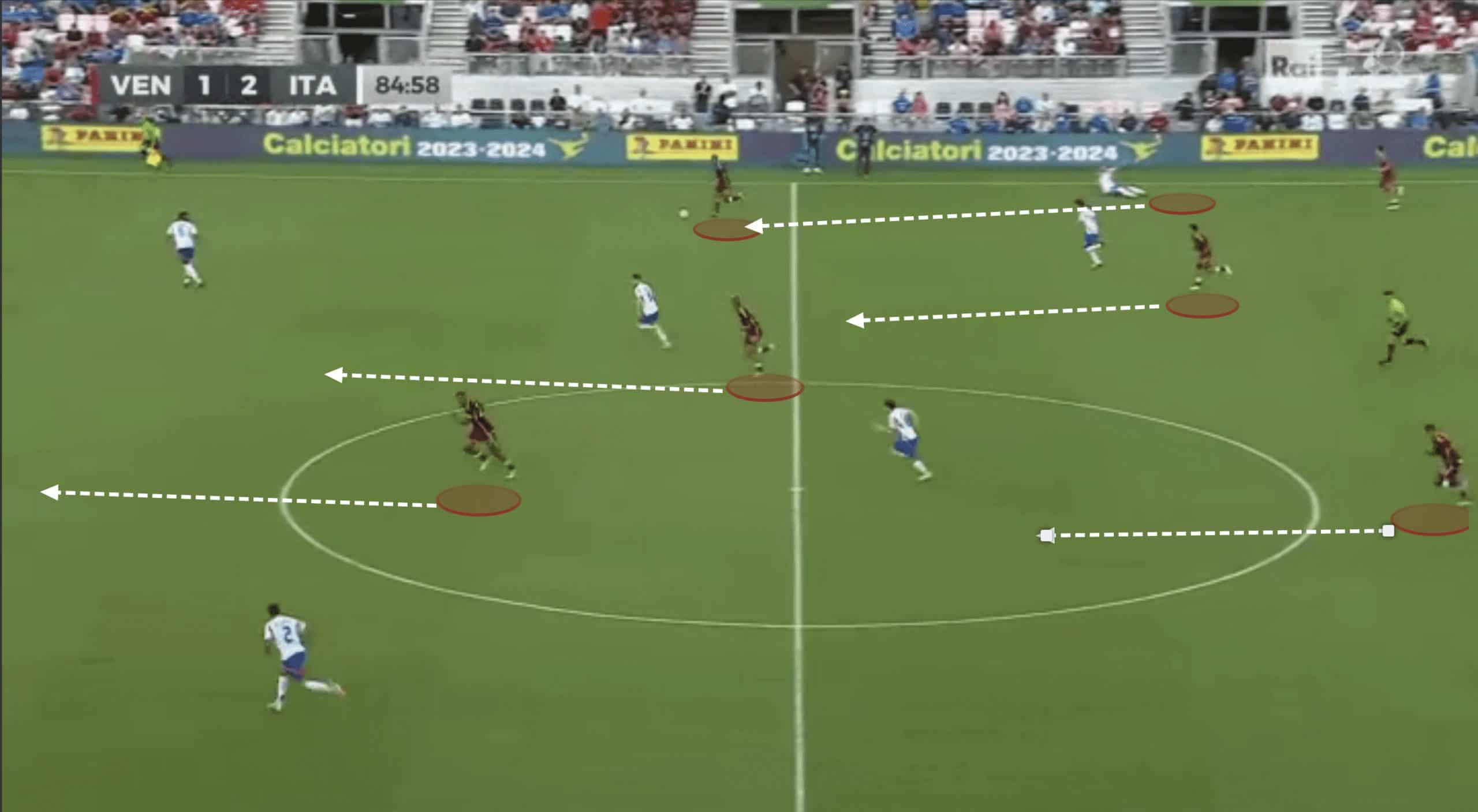
As we mentioned in the attacking section, Venezuela tend to look to attack mainly through aggressive moments of transition.
As soon as they regain possession in these situations, though, they will attack in numbers before the opposition can get set defensively around them.
In this example, we see that Venezuela regain possession wide on the far side against Italy.
They immediately have five players looking to move into attacking positions to attack space in the Italian defensive structure.
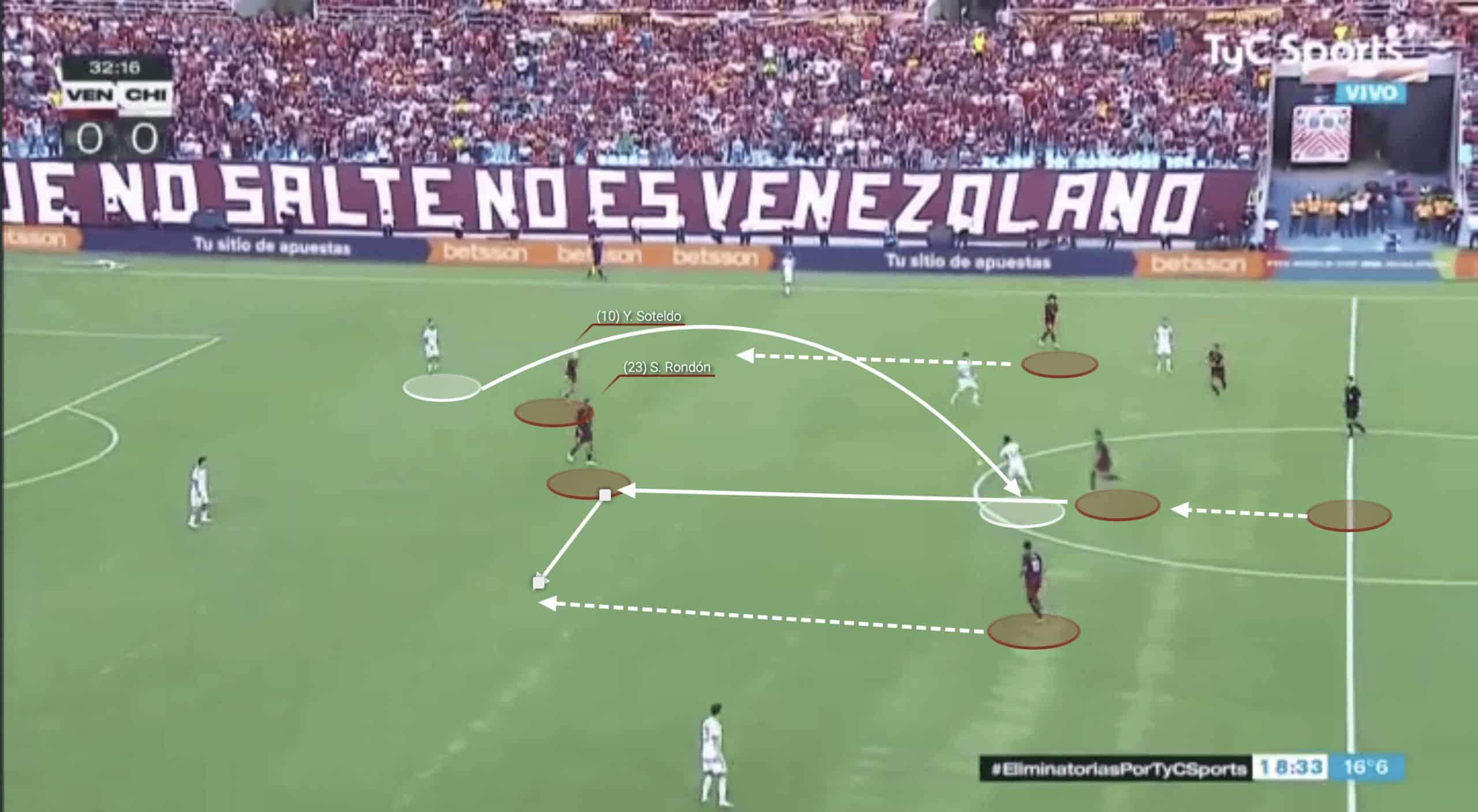
Here, we see a moment of transition for Venezuela when Chile lose the ball in the midfield.
As the initial pass out from the defenders is high and looping, the receiving player takes a loose touch and faces his own goal.
This immediately leads to a possession regained for Venezuela.
In these situations, their attacking approach is to look to play into the feet of Rondón, the striker.
Attacking players then make runs off of this pass to attack the space, as the opposition are poorly positioned at the point of transition.
Forwards
As we mentioned, there is no doubt that Pachuca forward Salomón Rondón will be the key attacking player for Venezuela.
Even at 34 years old, he is still the focal point for the national team to build their attacks through.
Behind him, Eric Ramírez, 25, and Jhonder Cádiz, 28, will provide balanced and younger options.
Midfielders
While Tomás Rincón still provides incredible experience in the midfield, Girona midfielder Yangel Herrera offers Venezuela the most leadership and quality in the midfield.
Jefferson Savarino and Darwin Machís offer attacking options wide, with Yeferson Soteldo supporting them.
Defenders
Venezuela have a lot of experience defensively, with Jhon Chancellor (32), Wilker Ángel (31), and Yordan Osorio (30) likely to play key roles in the central defensive positions.
As the wing-backs, however, Venezuela have real quality and youth in the Real Sociedad wing-back Jon Aramburu on the right and Miguel Navarro on the left.
Key Player
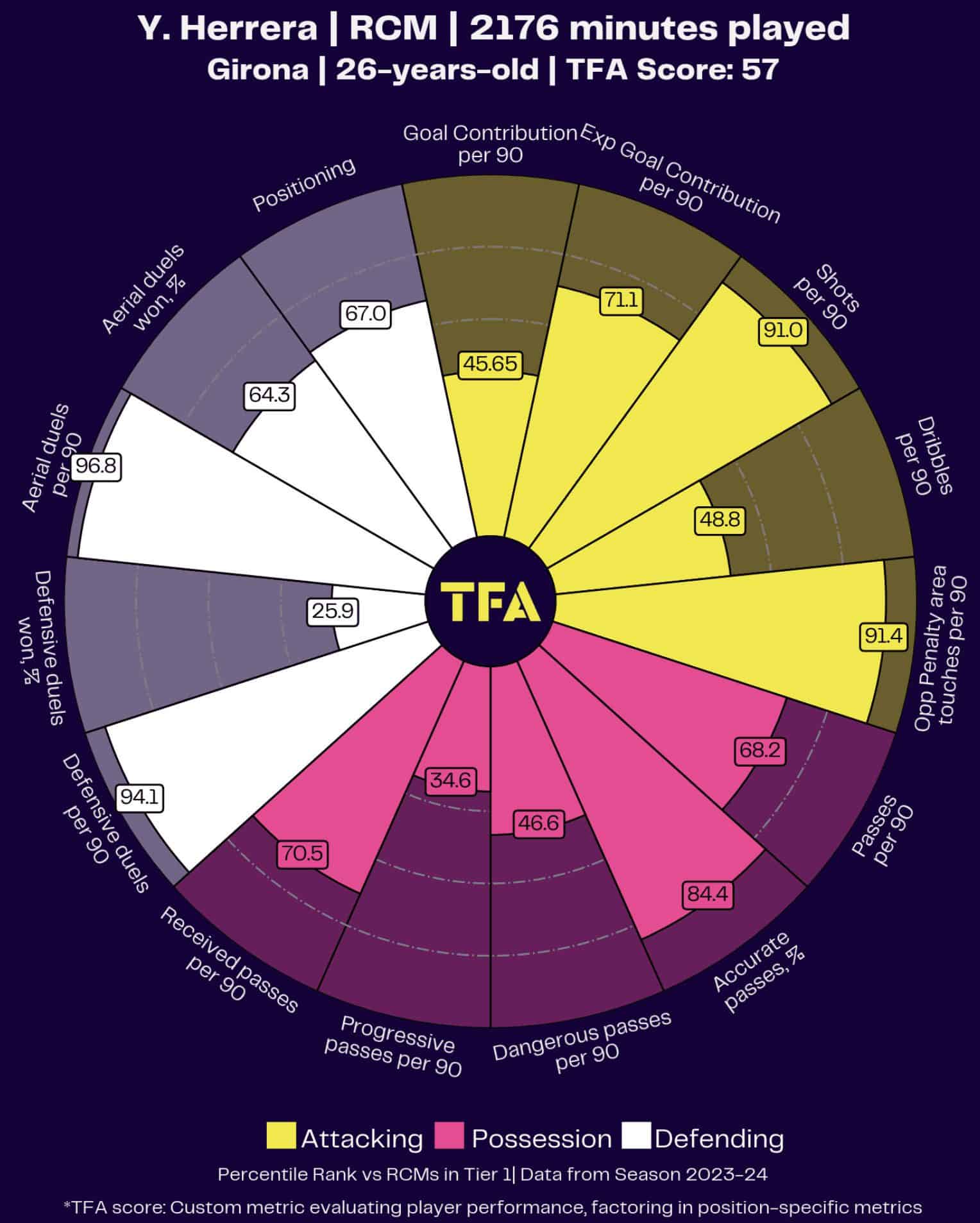
Yangel Herrera is still a key player for the Venezuelan national team, and as you can see, his all-action style of play provides a lot of quality at club level.
This season, we have seen Herrer perform very well in the Spanish top flight as Girona upset the odds to qualify for the Champions League.
The midfielder will need to provide a similar level of output this summer if Venezuela are going to be able to make a mark on the tournament.
Herrera can defend and break up play, but he is also extremely dangerous in moments of transition and when moving from deep to join the attacking phase.
Tournament Prediction
Getting out of the group stage for Venezuela is going to be a challenge, and both Ecuador and Mexico have strong squads with more depth in key positions than the Venezuelans.
If they do manage to get out of the group stages, though, then Venezuela will be difficult to beat in one-off knockout matches.

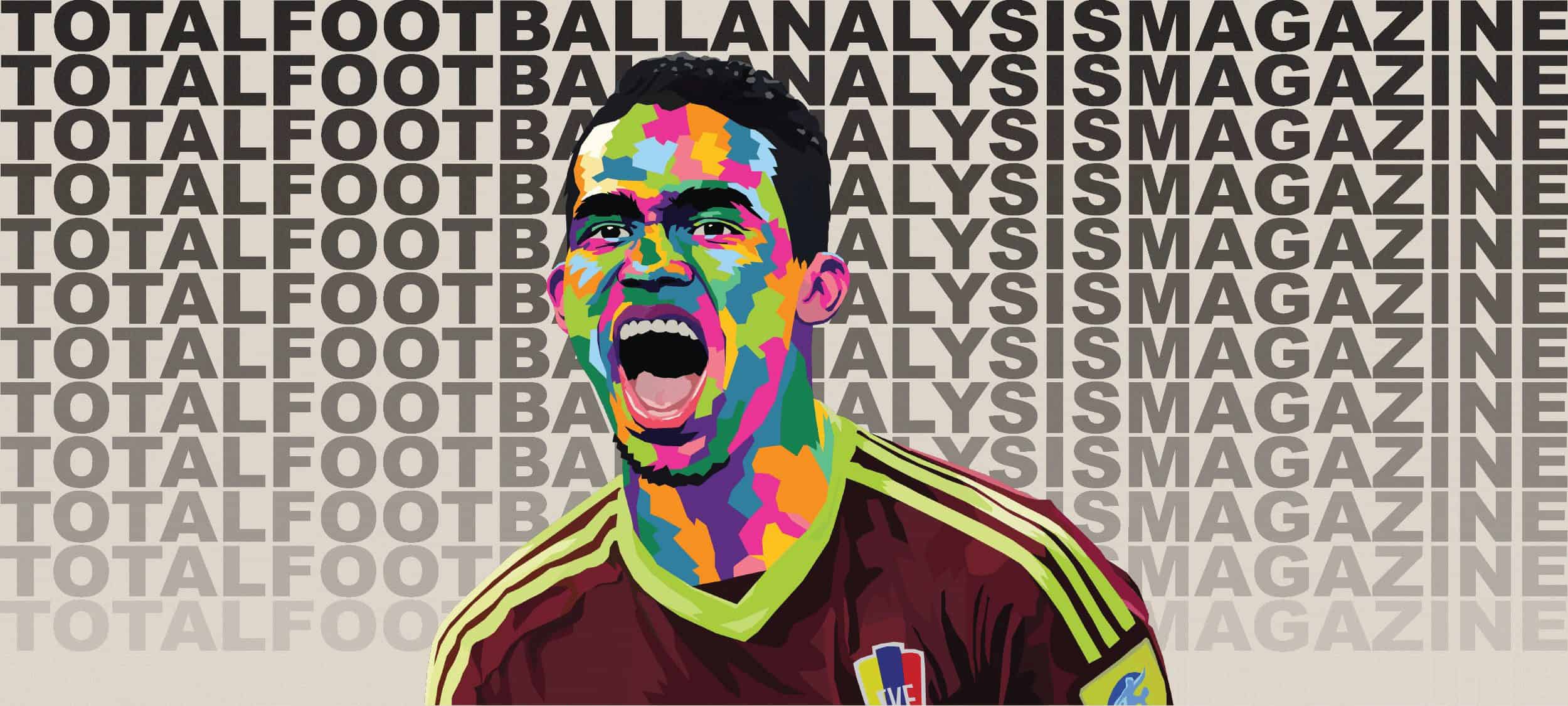




Comments